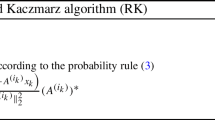Abstract
In this work, we adapt our algorithm for relaxations of periodic systems (Bucko et al. in J Chem Phys 122: 124508, 2005) in delocalized internal coordinates of Baker et al. (J Chem Phys 105: 192, 1996) for the use in transition state geometry optimizations. The abilities of our algorithm are demonstrated on examples of relaxations of atomic positions and cell geometries of systems with and without additional geometric constraints that include transition states for reactions of molecules in the gas phase, reconnection of H atoms in the one-dimensional periodic chain of \(\hbox {H}_2\) molecules, proton transfer in zeolite chabazite, partial desorption of crotonaldehyde from the MgO surface, and a pure affine shear deformation of Al. A simple approximate initial Hessian is suggested, in which only the matrix elements corresponding to atoms actively participating in reaction of interest are determined accurately at a DFT level, while remaining elements, typically related to inactive atoms and lattice vectors components, are defined on a basis of a simple empirical model. The calculations employing the approximate Hessian are shown to be more effective compared to simulations carried out with exact initial Hessian, in which all elements related to atomic positions are computed at the DFT level.






Similar content being viewed by others
References
Jensen F (1997) Introduction to computational chemistry. Wiley, Chichester
Press WH, Teukolsky SA, Vetterling WT, Flannery BP (2007) Numerical recipes: the art of scientific computing, 3rd edn. Cambridge University Press, New York, NY
Banerjee A, Adams N, Simons J, Shepard R (1985) Search for stationary-points on surface. J Phys Chem 89(1):52–57
Császár P, Pulay P (1984) Geometry optimization by direct inversion in the iterative subspace. J Mol Struct 114:31–34
Henkelman G, Jónsson H (1999) A dimer method for finding saddle points on high dimensional potential surfaces using only first derivatives. J Chem Phys 111(15):7010
Henkelman G, Jónsson H (2000) Improved tangent estimate in the nudged elastic band method for finding minimum energy paths and saddle points. J Chem Phys 113(22):9978–9985
Henkelman G, Jóhannesson G, H J (2005) Methods for finding saddle points and minimum energy paths. In: Schwartz SD (ed) Theoretical methods in condensed phase chemistry. Progress in theoretical chemistry and physics, Springer, Dordrecht, vol 5, pp 269–302
Caspersen KJ, Carter EA (2005) Finding transition states for crystalline solid–solid phase transformations. Proc Natl Acad Sci 102(19):6738–6743. https://doi.org/10.1073/pnas.0408127102
Sheppard D, Xiao P, Chemelewski W, Johnson DD, Henkelman G (2012) A generalized solid-state nudged elastic band method. J Chem Phys 136(7):074103
Xiao P, Sheppard D, Rogal J, Henkelman G (2014) Solid-state dimer method for calculating solid–solid phase transitions. J Chem Phys 140(17):174104
Bucko T, Hafner J, Angyan JG (2005) Geometry optimization of periodic systems using internal coordinates. J Chem Phys 122(12):124508
Baker J, Kessi A, Delley B (1996) The generation and use of delocalized internal coordinates in geometry optimization. J Chem Phys 105(1):192–212
Baker J, Chan FR (1996) The location of transition states: a comparison of cartesian, z-matrix, and natural internal coordinates. J Comput Chem 17(7):888–904
Peng C, Ayala PY, Schlegel HB, Frisch MJ (1996) Using redundant internal coordinates to optimize equilibrium geometries and transition states. J Comput Chem 17(1):49–56
Bakken V, Helgaker T (2002) The efficient optimization of molecular geometries using redundant internal coordinates. J Chem Phys 117(20):9160–9174
Andzelm J, King-Smith RD, Fitzgerald G (2001) Geometry optimization of solids using delocalized internal coordinates. Chem Phys Lett 335(3):321–326
Baker J, Pulay P (1996) Geometry optimization of atomic microclusters using inverse-power distance coordinates. J Chem Phys 105(24):11100–11107
Wilson EBJ, Decius JC, Cross PC (1955) Molecular vibrations. The theory of infrared and Raman vibrational spectra. Dover, New York
Bofill JM (1994) Updated Hessian matrix and the restricted step method for locating transition structures. J Comput Chem 15(1):1–11
Murtagh BA, Sargent RWH (1972) Comput J 13:185
Powell MJD (1971) Math Prog 1:26
Lindh R, Bernhardsson A, Karlstrom G, Malmquist PA (1995) On the use of a hessian model function in molecular-geometry optimizations. Chem Phys Lett 241(4):423–428
Fischer TH, Almlof J (1992) General methods for geometry and wave function optimization. J Phys Chem 96(24):9768–9774
Bučko T (2004) Structure, acidity, and chemical reactivity of zeolites. In: Thesis, University of Vienna, Vienna
Bucko T, Hafner J, Benco L (2004) Active sites for the vapor phase beckmann rearrangement over mordenite: an ab initio study. J Phys Chem A 108(51):11388–11397
Pu J, Truhlar DG (2005) Use of block hessians for the optimization of molecular geometries. J Chem Theory Comput 1(1):54–60
Rabi S (2014) Transition-state optimization methods using internal coordinates. In: Thesis. McMaster University
Kresse G, Hafner J (1993) Ab-initio molecular-dynamics for open-shell transition-metals. Phys Rev B 48(17):13115–13118
Kresse G, Hafner J (1994) Norm-conserving and ultrasoft pseudopotentials for first-row and transition-elements. J Phys Condens Matter 6(40):8245–8257
Kresse G, Furthmüller J (1996) Efficiency of ab-initio total energy calculations for metals and semiconductors using a plane-wave basis set. Comput Mater Sci 6(1):15–50
Kresse G, Furthmüller J (1996) Efficient iterative schemes for ab initio total-energy calculations using a plane-wave basis set. Phys Rev B 54(16):11169–11186
Blöchl PE (1994) Projector augmented-wave method. Phys Rev B 50:17953–17979
Kresse G, Joubert D (1999) From ultrasoft pseudopotentials to the projector augmented-wave method. Phys Rev B 59(3):1758–1775
Perdew JP, Burke K, Ernzerhof M (1996) Generalized gradient approximation made simple. Phys Rev Lett 77:3865–3868
Heyden A, Bell A, Keil F (2005) Efficient methods for finding transition states in chemical reactions: comparison of improved dimer method and partitioned rational function optimization method. J Chem Phys 123(22):224101
Fermann JT, Auerbach S (2000) Modeling proton mobility in acidic zeolite clusters: II. Room temperature tunneling effects from semiclassical rate theory. J Chem Phys 112(15):6787–6794
Sierka M, Sauer J (2001) Proton mobility in chabazite, faujasite, and ZSM-5 zeolite catalysts. comparison based on ab initio calculations. J Phys Chem B 105(8):1603–1613
Smith LJ, Davidson A, Cheetham AK (1997) A neutron diffraction and infrared spectroscopy study of the acid form of the aluminosilicate zeolite, chabazite (H- SSZ-13). Catal Lett 49(3):143–146
Taifan WE, Bučko T, Baltrusaitis J (2017) Catalytic conversion of ethanol to 1,3-butadiene on MgO: a comprehensive mechanism elucidation using DFT calculations. J Catal 346:78–91
Jahnatek M, Hafner J, Krajci M (2009) Shear deformation, ideal strength, and stacking fault formation of FCC metals: a density-functional study of Al and Cu. Phys Rev B 79:224103
Acknowledgements
TB is deeply indebted to Dr. János Gábor Ángyán for introducing him into the subject discussed in this work and for a long, fruitful, and always very pleasant collaboration on 'anything that was interesting’. This work was supported by the Slovak Research and Development Agency under the Contract No. APVV-15-0105. Calculations were performed using the supercomputing infrastructure of Computing Center of the Slovak Academy of Sciences acquired in projects ITMS 26230120002 and 26210120002 supported by the Research and Development Operational Program funded by the ERDF.
Author information
Authors and Affiliations
Corresponding author
Additional information
Published as part of the special collection of articles In Memoriam of János Ángyán.
Electronic supplementary material
Below is the link to the electronic supplementary material.
Rights and permissions
About this article
Cite this article
Bučko, T. Transition state optimization of periodic systems using delocalized internal coordinates. Theor Chem Acc 137, 164 (2018). https://doi.org/10.1007/s00214-018-2367-0
Received:
Accepted:
Published:
DOI: https://doi.org/10.1007/s00214-018-2367-0




